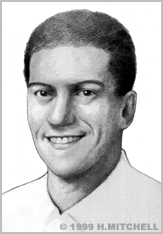Daniel DiLorenzo
Daniel DiLorenzo, an inventor since childhood, has created an impressive array of inventions in the fields of robotics and medical technology.
Born in Washington, D.C., DiLorenzo began his scientific career at age two and a half when he asked his parents, "What color is electricity?" His rudimentary attempts to solve that mystery using a screwdriver and wall socket soon led to more substantial experiments. By fifth grade, he had built his first circuit; by eighth grade, he had built an infrared voice transceiver, a programmable read-only memory, and his first robot.
DiLorenzo's eighth-grade robot was wheeled and could move its five-fingered hands, telescoping arms, wrists, shoulders, and waist. His eleventh-grade robot was computer-controlled. His twelfth-grade robot was quadrupedal. DiLorenzo spent his high school summers at the Naval Research Laboratory, where he developed, among other things, a two-axis robot arm with an innovative type of pincer.
DiLorenzo earned an SB in Electrical Engineering and Computer Science from the Massachusetts Institute of Technology (MIT). For his senior thesis, DiLorenzo created software enabling his quadrupedal robot to walk under computer control. Meanwhile, he had also invented an electronic, biofeedback-based system to treat enuresis (bed-wetting). By the time he graduated, DiLorenzo had been granted both a patent and FDA approval for this system and was marketing the device through a company he had founded.
After further work in controls that also earned him an SM from MIT, DiLorenzo began to apply his expertise in computers and engineering to medical devices. He entered the joint MD/PhD program in the Harvard-MIT Division of Health Sciences and Technology, where he specialized in systems that compensate for various neurological deficits.
DiLorenzo designed, built, and microsurgically implanted neuroelectric interfaces that provide a patient with the sensory feedback otherwise lacking in paralyzed or even prosthetic limbs. As a PhD candidate at MIT and later as a dual degree student in the Harvard-MIT Division of Health Sciences and Technology, he invented a Functional Electrical Stimulation (FES) control system that allows a paraplegic patient to walk sixty feet with only balance assistance. In addition to these artificial neurological transmitters and receivers, DiLorenzo invented a number of surgical tools, retinal implants, and a device that controls brain swelling during surgery, which is now patented.
Still very much the entrepreneur-inventor, DiLorenzo completed an MBA in the management of technology at the MIT Sloan School of Management in 1999, studying the strategies and determinants of success in medical start-up ventures. In recognition of his inventive achievements, Daniel DiLorenzo was awarded the 1999 Lemelson-MIT Student Prize.
In 2004, DiLorenzo founded BioNeuronics Corporation (now NeuroVista Corporation), a company that develops medical technology for the management and treatment of epilepsy. He serves as a chief advisor of NeuroVista Corporation and runs DiLorenzo Biomedical LLC, which develops neurotherapeutic medical devices.


